

Sabine Pass is the natural outlet of Sabine Lake into the Gulf of Mexico. [1] It borders Jefferson County, Texas, and Cameron Parish, Louisiana. [1]


Sabine Pass is the natural outlet of Sabine Lake into the Gulf of Mexico. [1] It borders Jefferson County, Texas, and Cameron Parish, Louisiana. [1]
Two major battles occurred here during the American Civil War, known as the First and Second Battles of Sabine Pass. [2] [3]
In May 1898, the 55th United States Congress authorized the establishment of two seacoast defense forts at Sabine Pass relative to the Texas Gulf Coast. [4] The fortifications were a response as hostilities intensified in the Gulf of Mexico during the Cuban War of Independence often referred as the Spanish–American War. In 1983, Texas Historical Commission acknowledged the seacoast defense command posts establishing a Texas historical marker at the Sabine Pass Battleground State Historic Site. [5]
In 1941, the United States authorized a coastal artillery emplacement and Harbor Entrance Control Post at the Sabine Pass natural waterway inlet as a response to Battle of the Atlantic better known as Operation Drumbeat orchestrated by Nazi Germany. [6] The Sabine Pass military base exhibited checkpoint and guard end stations, coastal searchlights, coastal signal stations, and an observation tower. The coastal defence and fortification incorporated an artillery battery command post complementary as a Coast Guard lifeboat station initially chartered in 1870s as the United States Life-Saving Service. [7]
The Sabine Pass coastal defense installation was deemed military surplus as the United States Department of War operations tapered by 1945.
The channel is also the only conceivable way that ships produced by shipyards in Orange and Beaumont could have reached the seas.
A powerful storm made landfall at Sabine Pass on October 12, 1886. [8] It was the tenth hurricane of the season, now referred to as The Texas-Louisiana Hurricane of 1886, that all but wiped out Sabine Pass and Johnson Bayou in Cameron Parish. The storm, now considered to have been a category 3 (Saffir–Simpson scale), resulted in at least 196 deaths. Occurrence of the storm was recorded in the controversial "Diary of Louise" on October 20, 1886. [9] [ dead link ][ needs context ]
Hurricane Rita made landfall on September 24, 2005, and on September 12–13, 2008, Hurricane Ike struck Sabine Pass and Galveston, [10] generating the highest surge [11] of 22 feet (6.7 meters) which is, according to the North American Vertical Datum of 1988 (NAVD 88), [12] the highest ever recorded at Sabine Pass. [13]
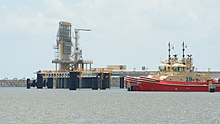
Sabine Pass is a site for an LNG terminal because it is located along one of a few deepwater ports along the Gulf Coast suitable for LNG. The region also has an existing pipeline infrastructure with access to South East Texas and U.S. markets. The terminal can import LNG, [14] as well as export up to 30 million tonnes of LNG per year. [15]
The former city of Sabine Pass, Texas, is now a neighborhood of Port Arthur.
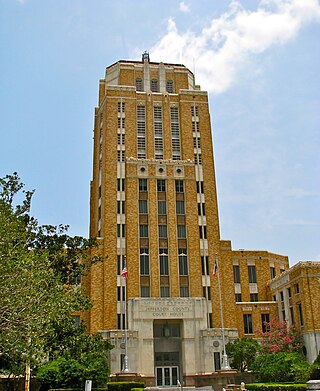
Jefferson County is a county in the Coastal Plain or Gulf Prairie region of Southeast Texas. The Neches River forms its northeastern boundary. As of the 2020 census, the population was 256,526. The county seat is Beaumont. Jefferson County has the highest percentage of African Americans in the state of Texas.

Port Arthur is a city in the U.S. state of Texas, 90 mi (140 km) east of Houston. Part of the Beaumont–Port Arthur metropolitan area, Port Arthur lies primarily in Jefferson County, with a small, uninhabited extension in Orange County. The largest oil refinery in the United States, the Motiva Refinery, is located there.

Sabine Lake is a bay on the Gulf coasts of Texas and Louisiana, located approximately 90 miles (140 km) east of Houston and 160 miles (260 km) west of Baton Rouge, adjoining the city of Port Arthur. The lake is formed by the confluence of the Neches and Sabine Rivers and connects to the Gulf of Mexico through Sabine Pass. It forms part of the Texas–Louisiana border, falling within Jefferson and Orange Counties in Texas and Cameron Parish, Louisiana.
Sabine Pass is a neighborhood in Port Arthur, Texas. It had been incorporated in 1861 before being formally annexed by Port Arthur in 1978. However, Sabine Pass retains its own distinct identity with its own school district, post office, water district, and port authority. The Port Arthur Convention and Visitors Bureau stated that Sabine Pass is "often regarded as" being a "self-contained" community.
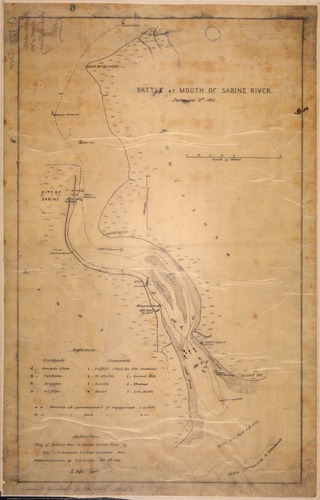
The Second Battle of Sabine Pass was a failed Union Army attempt to invade the Confederate state of Texas during the American Civil War. The Union Navy supported the effort and lost three gunboats during the battle, two captured and one destroyed.

The Sabine Pass Lighthouse, or Sabine Pass Light as it was referred to by the United States Coast Guard, is a historic lighthouse, as part of a gulf coast light station, on the Louisiana side of the Sabine River, in Cameron Parish, across from the community of Sabine Pass, Texas. It was first lit in 1857 and was deactivated by the Coast Guard in 1952. One of only three built in the United States of similar design, the light was listed on the National Register of Historic Places as "Sabine Pass Lighthouse" on December 17, 1981. It is now abandoned but has long continued to be the subject of preservation efforts.
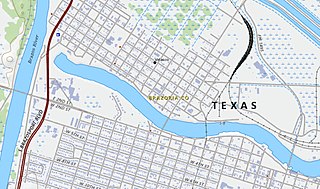
Velasco was a town in Texas, United States, that was later merged with the city of Freeport by an election conducted by eligible voters of both municipalities on February 9, 1957. The consolidation effort passed by a margin of 17 votes. Founded in 1831, Velasco is situated on the east side of the Brazos River in southeast Texas. It is 16 miles (26 km) south of Angleton, and 4 miles (6.4 km) from the Gulf of Mexico.

Richard William "Dick" Dowling was an Irish-born artillery officer of the Confederate States Army who achieved distinction as commander at the battle of Sabine Pass (1863), the most one-sided Confederate victory during the American Civil War. It is considered the "Thermopylae of the Confederacy" and prevented Texas from being conquered by the Union. For his actions, Dowling received the "thanks of Congress", Davis Guards Medal, Southern Cross of Honor, and Confederate Medal of Honor. Over a dozen other memorials have also been dedicated in his honor.

Johnson Bayou is a small unincorporated community located on the Creole Nature Trail along the Gulf Coast in Cameron Parish, Louisiana, United States, and is named after Daniel Johnson, who came to the area circa 1790. The village is a barrier island spread across coastal chenieres which were formed by deltaic sedimentation by the shifting of the Mississippi River. This geologic formation, the coastal cheniere, is found only in a few locations across the globe. The population of the community was approximately 400 before Hurricanes Laura and Delta devastated the community in August and October of 2020. By September of 2021 the population had recovered to almost 300.

Fort Duncan was a United States Army base, set up to protect the first U.S. settlement on the Rio Grande near the current town of Eagle Pass, Texas.

Tropical Storm Cindy was a strong tropical storm which impacted portions of the United States Gulf Coast in September 1963. The third named storm of the 1963 Atlantic hurricane season, Cindy developed within a trough as a tropical storm in the Gulf of Mexico on 16 September. The disturbance quickly intensified, with a distinct eye becoming visible on satellite imagery as it drifted north-northwestwards toward the Texas coastline. After peaking with 1-minute maximum sustained winds of 65 mph (100 km/h), it made landfall at High Island on the morning of 17 September at peak strength with an atmospheric pressure of 997 mbar. Cindy remained nearly stationary for almost a day, dropping copious rainfall over the Texas coastal plain, before finally turning west-southwestward and dissipating west of Corpus Christi on 20 September.
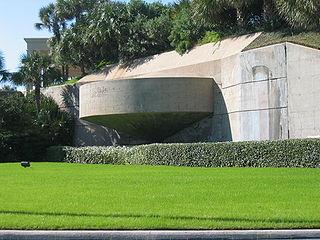
Fort Crockett is a government reservation on Galveston Island overlooking the Gulf of Mexico originally built as a defense installation to protect the city and harbor of Galveston and to secure the entrance to Galveston Bay, thus protecting the commercial and industrial ports of Galveston and Houston and the extensive oil refineries in the bay area. The facility is now managed by the US NOAA National Marine Fisheries Service, and hosts the Bureau of Commercial Fisheries Laboratory, the Texas Institute of Oceanography, as well as some university facilities. The area still contains several historical buildings and military fortifications.
The Forts of Texas include a number of historical and operational military installations. For over 200 years, various groups fought over access to or control over the region that is now Texas. Possession of the region was claimed and disputed by the European powers of Spain and France, and the continental countries of Mexico, the United States, the Republic of Texas, and the Confederate States of America. Ownership of specific lands was claimed and disputed by different ethnic groups, including numerous Native American tribes, Mexican residents, Anglo- and African-American settlers, and European immigrants. Access to and control of resources were claimed and disputed by various economic groups, including indigenous hunter/gatherers, farmers, herders, ranchers, colonists, settlers, buffalo hunters, traders, bandits, smugglers, pirates, and revolutionaries. Over the centuries, claims and disputes were enforced by Native American warriors, Spanish conquistadors, French cavaliers, Texas Rangers, local militias, and uniformed regular army regiments of Spain, Mexico, Texas, the United States, and the Confederacy.
The Climate of Beaumont, Texas covers the averages and extremes in past weather seen within the city of Beaumont, Texas. The city is within the humid subtropical climate regime, and is within the Piney Woods region of eastern Texas. The area around Beaumont receives the most rainfall in the state: more than 65 inches (1,700 mm) annually. Summers in the area are usually hot and humid, due to the moisture that flows inland off of the Gulf of Mexico. Winters are usually kept mild by the warm gulf waters. Hurricanes also pose a threat to the area. Hurricane Harvey in 2017, Hurricane Rita in 2005, and Hurricane Ike in 2008 were the most recent significant storms to strike.

Texas Gulf Coast is an intertidal zone which borders the coastal region of South Texas, Southeast Texas, and the Texas Coastal Bend. The Texas coastal geography boundaries the Gulf of Mexico encompassing a geographical distance relative bearing at 367 miles (591 km) of coastline according to CRS and 3,359 miles (5,406 km) of shoreline according to NOAA.

Sabine Pass Battleground State Historic Site is located in Jefferson County, Texas, where the Sabine River enters the Gulf of Mexico. The site is the location of a significant Civil War battle.

The 1940 Louisiana hurricane caused record flooding across much of the Southern United States in August 1940. The second tropical cyclone and hurricane of the annual hurricane season, it formed from a frontal low off the west coast of Florida on August 3. Initially a weak disturbance, it moved generally westward, slowly gaining in intensity. Early on August 4, the depression attained tropical storm intensity. Ships in the vicinity of the storm reported a much stronger tropical cyclone than initially suggested. After reaching hurricane strength on August 5 south of the Mississippi River Delta, the storm strengthened further into a Category 2 hurricane with maximum sustained winds of 100 mph and a minimum barometric pressure of 972 mbar at 0600 UTC on August 7. The hurricane moved ashore near Sabine Pass, Texas later that day at peak strength. Once inland, the storm executed a sharp curve to the north and quickly weakened, degenerating into a tropical storm on August 8 before dissipating over Arkansas on August 10.

Aransas Pass Light Station also called Lydia Ann Lighthouse is an historic light station in Aransas County, Harbor Island, just outside the city limits of Port Aransas, Texas, behind San Jose and Mustang Islands, that protects a natural gulf pass to Aransas and Corpus Christi Bays.

Allen Depot was established in 1876 in the central ward of Allen, Texas. The train depot served as a water stop for the Galveston and Red River Railway chartered by Ebenezer Allen in 1848. By 1856, the Southeast Texas to Red River railroad would transition to the Houston and Texas Central Railway.

Brazos Santiago Pass is a natural coastal landform located in the Lower Laguna Madre and Lower Rio Grande Valley on the furthest southern beach terrain of the Texas Gulf Coast. The seacoast passage is interpolated by barrier islands encompassing the southern Brazos Island and the northern South Padre Island.